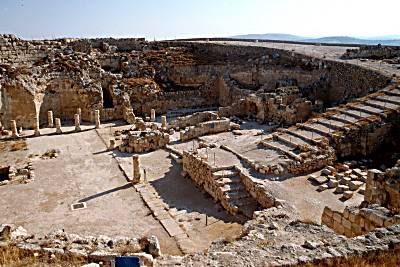King Herod's Tomb Discovered

A team of archaeologists have uncovered a tomb and a rich assortment of what they describe as "kingly" artifacts deep beneath what remains of King Herod's ancient fortress palace of Herodion. The features and artifacts associated with the tomb include a stone-lined tomb, richly decorated sarcophagus, a large gold bier inlaid with gem stones, a well-preserved gold scepter, and a gold crown also bedecked with an assortment of gem stones. The sarcophagus contained no remains, although this is not surprising to some members of the team, who suggest that Herod likely would have arranged to have his skeletal remains eventually interred in an ossuary (stone box), according to the Jewish tradition of the time. This, of course, assumes that the tomb can indeed be identified as that of Herod, himself. Ground Penetrating Radar (GPR) instruments first offered clues of a cavity and other telltale features months before serious excavations began. The GPR lead soon prompted a "rapid response team" organized by the Israel Antiquities Authority, along with all the trappings of heightened security precautions (to prevent potential looting). If the finding is confirmed, some scholars are suggesting that the discovery would rival the excitement that surrounded the tomb and treasures of Tutankhamen, at least in terms of its popular appeal.
The reader might be a little disappointed to learn that the above report is fictitious. According to the writings of Josephus, King Herod planned to be buried at Herodion, and his funeral ceremony and procession did take place at that location. A series of archaeological investigations and excavations have, however, failed to surface any evidence of his tomb. The mystery awaits the efforts of future investigations of the site. Like the enigma of King Herod's tomb, there are many more secrets awaiting discovery beneath the surface in that part of the world. As of this writing, there are at least 21 planned excavations for the summer of 2005 in Israel and Jordan. Even if you are not a student or a professional archaeologist, you can be a meaningful part of those efforts. As a volunteer, you do not need specialized training as a prerequisite. All you need is a real interest and a willingness to learn and contribute. The professionals will train you and give you an education you cannot get in the classroom. If you are interested, check out the list of digs at the Biblical Archaeology Society, and the list provided by the Archaeological Institute of America. It could be the start of something that will create a memory for life.



1 Comments:
This image is amazing. I'd love to use it. Do you own the copyright? if so, email me at amanda@kaleidoscopeme.com. thanks!
Post a Comment
<< Home